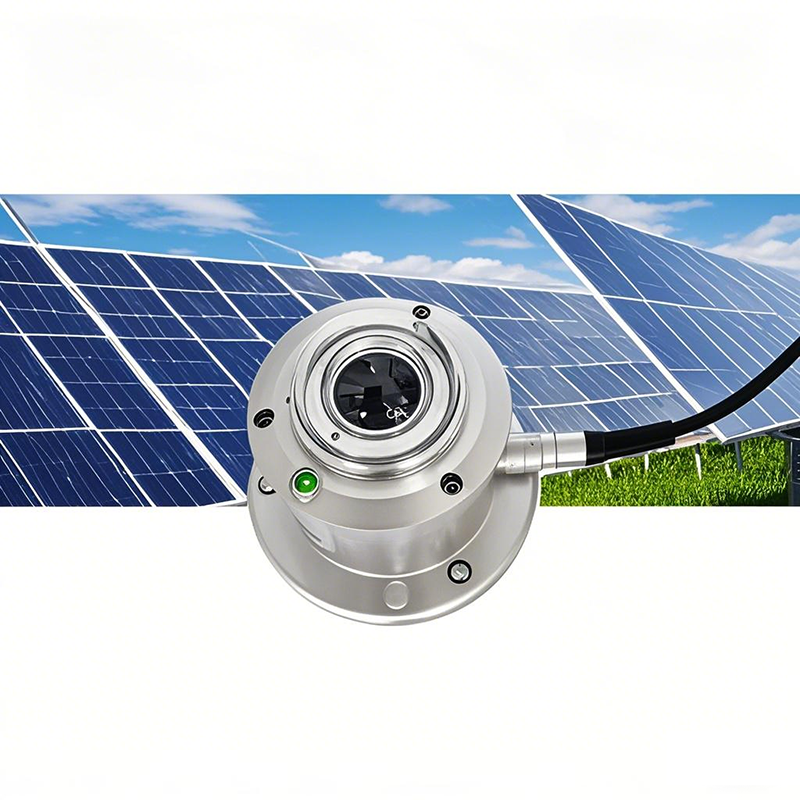پائيدار توانائي جي طرف عالمي رجحان ۾، شمسي توانائي جي پيداوار سڀ کان وڌيڪ اميد رکندڙ صاف توانائي ذريعن مان هڪ بڻجي چڪي آهي. شمسي توانائي جي پيداوار جي نظام جي هڪ اهم جزو جي طور تي، تابڪاري جي نگراني جو سامان، خاص طور تي عالمي تابڪاري سينسرز جو استعمال، انتهائي اهم آهي. هي مضمون شمسي توانائي پلانٽس لاءِ عالمي تابڪاري سينسرز جي خاصيتن ۽ فائدن ۽ بجلي جي پيداوار جي ڪارڪردگي کي بهتر بڻائڻ ۾ انهن جي اهم ڪردار کي متعارف ڪرايو ويندو.
گلوبل ريڊيئيشن سينسر ڇا آهي؟
هڪ گلوبل ريڊيئيشن سينسر هڪ اوزار آهي جيڪو شمسي تابڪاري جي شدت کي ماپڻ لاءِ استعمال ٿيندو آهي. اهو شمسي تابڪاري جي ڪل مقدار کي صحيح طور تي مانيٽر ڪري سگهي ٿو. اهي سينسر عام طور تي روشني توانائي کي برقي سگنلن ۾ تبديل ڪرڻ ۽ تابڪاري قدرن کي صحيح طور تي ڏيکارڻ لاءِ فوٽو اليڪٽرڪ اثر يا ٿرمو اليڪٽرڪ اثر جي اصول کي استعمال ڪندا آهن. شمسي بجلي گهرن لاءِ، شمسي تابڪاري کي سمجهڻ ۽ نگراني ڪرڻ بجلي پيدا ڪرڻ جي ڪارڪردگي کي بهتر بڻائڻ لاءِ هڪ اهم بنياد آهي.
عالمي تابڪاري سينسر جون خاصيتون ۽ فائدا
اعليٰ درستگي جي ماپ
عالمي تابڪاري سينسر ۾ ماپ جي درستگي تمام گهڻي آهي ۽ اهو حقيقي وقت ۾ تابڪاري جي شدت ۾ تبديلين جي نگراني ڪري سگهي ٿو. صحيح ڊيٽا موٽ سان، پاور پلانٽ فوٽووولٽڪ پينلز جي زاويه ۽ پوزيشن کي وڌيڪ اثرائتي طريقي سان ترتيب ڏئي سگهن ٿا ته جيئن بهترين روشني حاصل ڪري سگهجي.
ريئل ٽائيم ڊيٽا مانيٽرنگ
سينسر کي حقيقي وقت ڊيٽا مانيٽرنگ ۽ تجزيو حاصل ڪرڻ لاءِ ڊيٽا حاصل ڪرڻ واري نظام سان ڳنڍي سگهجي ٿو. ڪلائوڊ پليٽ فارم ذريعي، مئنيجر ڪنهن به وقت ۽ ڪٿي به تابڪاري ڊيٽا ڏسي سگهن ٿا، جلدي جواب ڏئي سگهن ٿا ۽ روزاني آپريشن کي بهتر بڻائي سگهن ٿا.
استحڪام ۽ استحڪام
جديد ڪل ريڊيئيشن سينسر عام طور تي پنروڪ، مٽيءَ کان بچاءُ ۽ اعليٰ گرمي پد جي مزاحمتي مواد مان ٺهيل هوندا آهن، جيڪي مختلف سخت استعمال واري ماحول ۾ مستحڪم آپريشن برقرار رکي سگهن ٿا، سار سنڀال جي خرچن کي گهٽائي سگهن ٿا، ۽ پاور پلانٽس لاءِ ڊگهي مدت جون خدمتون مهيا ڪري سگهن ٿا.
آسان تنصيب ۽ سار سنڀال
ڪل ريڊيئيشن سينسر جي ڊيزائن ان کي انسٽال ڪرڻ آسان بڻائي ٿي، پيچيده سيٽنگن کان سواءِ، مزدوري جي قيمت گھٽائي ٿي. ساڳئي وقت، ڊيٽا جي مسلسل درستگي کي يقيني بڻائڻ لاءِ باقاعده سار سنڀال پڻ تمام سادو آهي.
شمسي توانائي پلانٽس ۾ ڪل ريڊيئيشن سينسرز جو استعمال
بجلي پيدا ڪرڻ جي نظام کي بهتر بڻائڻ
ريڊيئيشن ڊيٽا جي حقيقي وقت جي نگراني ۽ تجزيو ذريعي، سولر پاور پلانٽ فوٽووولٽڪ ماڊلز جي ترتيب کي لچڪدار طريقي سان ترتيب ڏئي سگهن ٿا، فوٽو اليڪٽرڪ ڪنورشن ڪارڪردگي کي بهتر بڻائي سگهن ٿا، ۽ يقيني بڻائي سگهن ٿا ته بجلي پيدا ڪرڻ وارو نظام بهترين حالت ۾ ڪم ڪري.
نقص جي ڳولا ۽ اڳڪٿي ڪندڙ سار سنڀال
ڪُل ريڊيئيشن سينسر پاران گڏ ڪيل ڊيٽا سان، آپريشن ٽيم جلدي ممڪن غلطي جي مسئلن جي سڃاڻپ ڪري سگهي ٿي، اڳواٽ سار سنڀال ۽ اوور هال ڪري سگهي ٿي، ۽ وڏي پيماني تي ڊائون ٽائيم نقصان کان بچي سگهي ٿي.
ڊيٽا تي ٻڌل فيصلي جي حمايت
ڪل ريڊيئيشن سينسر پاران مهيا ڪيل صحيح ڊيٽا مئنيجرن کي سائنسي آپريشنل فيصلا ڪرڻ جي قابل بڻائي ٿو، جنهن ۾ بجلي جي پيداوار جي اڳڪٿي، بجلي جي پيداوار جي تشخيص وغيره شامل آهن، انهي ڪري مجموعي فائدن کي بهتر بڻائي ٿو.
ماحولياتي ۽ پاليسي جواب
صحيح تابڪاري ڊيٽا پاور پلانٽس کي بجلي جي پيداوار تي ماحولياتي تبديلين جي اثر جو جائزو وٺڻ ۾ پڻ مدد ڪري سگهي ٿي، انهي کي يقيني بڻائي سگهجي ٿو ته انهن جا آپريشن موسمياتي تبديلي جي پاليسين ۽ لاڳاپيل ضابطن جي تعميل ڪن ٿا، ۽ پائيدار ترقي ۾ حصو وٺن ٿا.
ٿڪل
قابل تجديد توانائي جي وڌندڙ عالمي طلب سان، شمسي توانائي جي پيداوار مستقبل جي توانائي جي ترتيب ۾ وڌيڪ اهم ڪردار ادا ڪندي. شمسي توانائي پلانٽس لاءِ بنيادي نگراني جي اوزار جي طور تي، ڪل ريڊيئيشن سينسر نه رڳو ڪمپنين کي بجلي جي پيداوار جي ڪارڪردگي کي بهتر بڻائڻ ۾ مدد ڪري سگهن ٿا، پر انهن جي صحيح ڊيٽا گڏ ڪرڻ جي صلاحيتن سان آپريٽنگ خرچن کي به گهٽائي سگهن ٿا، اقتصادي ۽ ماحولياتي فائدن ۾ هڪ جيت-جيت صورتحال حاصل ڪري سگهن ٿا.
جيڪڏهن توهان وٽ شمسي توانائي پلانٽس لاءِ ڪل ريڊيئيشن سينسر بابت ڪو سوال آهي، يا اسان جي شين بابت وڌيڪ ڄاڻڻ چاهيو ٿا، ته مهرباني ڪري اسان سان رابطو ڪرڻ ۾ آزاد محسوس ڪريو. اچو ته گڏجي ڪم ڪريون ته جيئن سائي توانائي جي مستقبل کي فروغ ڏئي سگهجي!
پوسٽ جو وقت: مئي-13-2025


